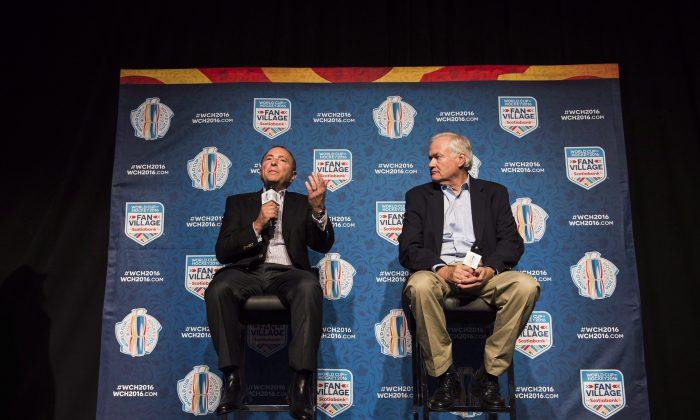TORONTO—The World Cup of Hockey is showcasing a fantastic product on the ice, but what doesn’t get enough attention are the game’s social inclusion contributions.
The first-ever Hockey Sense Summit, held at the Hockey Hall of Fame on Sept. 19, focused on the positive impact hockey has made and will continue to make on social issues such as diversity and inclusion.
The World Cup itself has grown out of improved cooperation between the NHL and its Players’ Association. NHL commissioner Gary Bettman and NHLPA executive director Don Fehr reiterated that sport is a powerful means for sending a message.
“We believe that hockey can bring people together and we’re a vivid example of that in practice,” Bettman said, referring to the two teams of North America and Europe—a new wrinkle for the tournament, but one that is looking like a stroke of genius.
“You need these kinds of events to do that because it highlights not the differences; it highlights the common interests of people and fans and how they can relate together,” Fehr said.
Three of the distinguished panellists—Harnarayan Singh, Igor Larionov, and Willie O'Ree—shared compelling personal accounts of how they’ve given to the game that changed their lives. Their stories speak to how, through hockey, they’ve opened doors for countless others through pursuing their dreams.
Colour Barrier Shattered
O'Ree broke hockey’s colour barrier in 1958 with the Boston Bruins and has since received numerous awards, including the Order of Canada in April 2010.
“I was just there, just playing, trying to be the best that I could,” O'Ree said about the two games he played against Montreal in 1958. He said he wasn’t caught up in being the first black player to play in the NHL and didn’t let any insults bother him.
Now, at the age of 80, O‘Ree is involved with Hockey Is For Everyone (HIFE) and holds on- and off-ice clinics and fundraisers. The cost of hockey equipment and ice time is very expensive and O’Ree said he’s just giving back to the game what it gave him.
Unlikely Broadcaster
There may not be a more unlikely hockey success story than that of Harnarayan Singh. Now the familiar voice of Hockey Night in Canada in Punjabi, Singh’s story of achieving his dream against all odds and gaining acceptance through hockey shows how barriers can be broken down.
Singh was always told that if he wanted to be a broadcaster, he should stick to news. That didn’t stop him. His energetic and passionate play-by-play calling of the game is not unlike South American announcers calling a soccer game.
His call of Nick Bonino game-winner in Game 1 of last year’s Stanley Cup final went viral and earned him international fame. Singh has called over 550 NHL games now, and explained that through hockey—that common ground—his passion for it was infectious.
“Hockey was that icebreaker,” he said. The more he talked about hockey, the more others realized he had a lot in common with them, despite how different he looked being a Sikh wearing a turban.
And he has heard of this scenario replaying itself in other environments.
“A lot of people have told us they didn’t have as much camaraderie, but now they have better relationships at work with their colleagues,” he said, regarding talking hockey in the workplace.
The Professor
Hall-of-Famer Larionov rose to prominence with the former USSR as part of the famed “KLM” line that would become one of the greatest lines in international hockey history.
Larionov said the 1981 Canada Cup planted a seed in him that made him look beyond the Soviet Union. He liked the Canadian style of play. “Never give up, play until the last minute,” he recounted.
Along with teammate Slava Fetisov, he publicly fought against the communist system and eventually was given permission to play in the NHL.
Larionov said it took a while to feel at ease with the Vancouver Canucks in 1989. He had proven himself with the Soviet Union national team, but at 29, he had to prove himself all over again. With his Soviet Red Army team, he was told what to do 11 months a year, but now in the NHL, he had freedom like he never had before.
Winner of three Stanley Cups with Detroit, Larionov is known as a pioneer and earned the nickname “The Professor” for his cerebral way of playing. Now, thanks largely to his efforts, Russia’s best players play in the NHL.
“Doesn’t matter what passport you have,” he said, reflecting on how times have changed over 40 years. “If you’re a good hockey player, you have a chance to make it.”
Singh said it best for the role that sport and hockey can play in Canada.
“Sport is a way for social inclusion,” he said. “Canada is that example to the world. Hockey does break down barriers and bridge the gap between cultures.”
Follow Rahul on Twitter @RV_ETSports






Friends Read Free